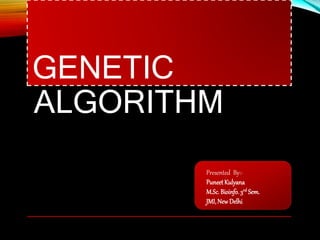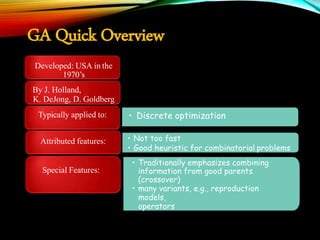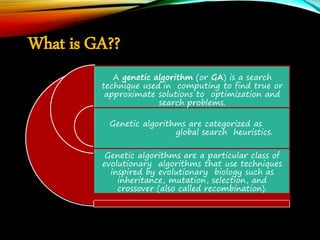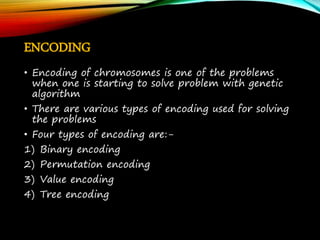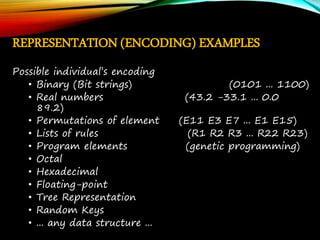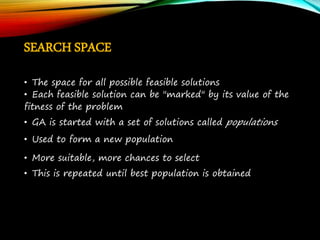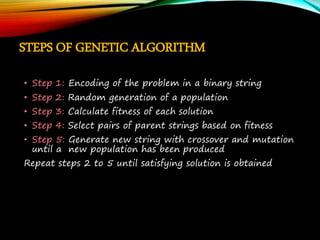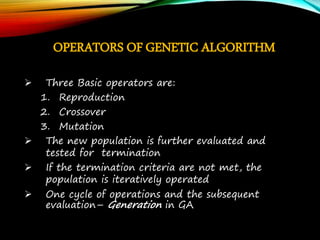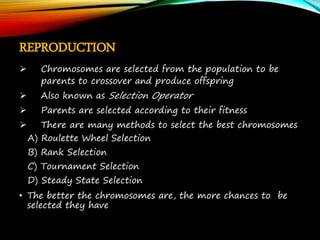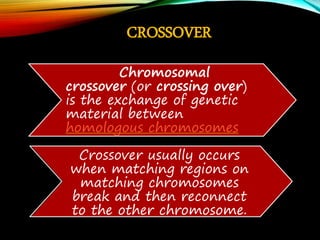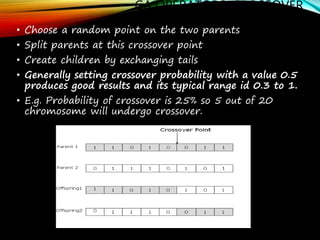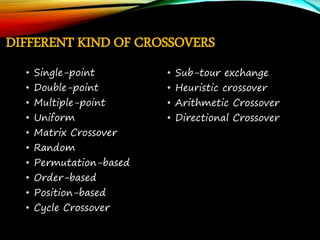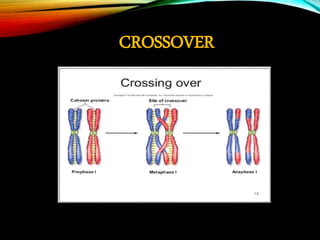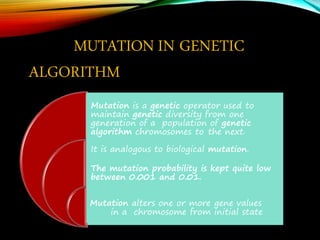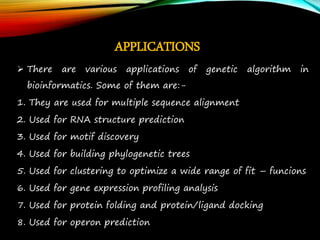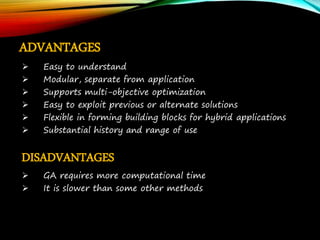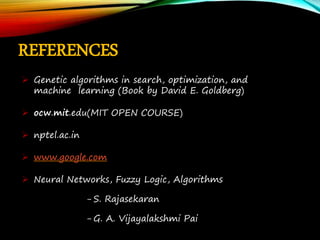MACHINE LEARNING - GENETIC ALGORITHM
- 1. GENETIC ALGORITHM Presented By:- Puneet Kulyana M.Sc. Bioinfo.3rd Sem. JMI,NewDelhi
- 2. GA Quick Overview Developed: USA in the 1970ŌĆÖs By J. Holland, K. DeJong, D. Goldberg ŌĆó Discrete optimizationTypically applied to: ŌĆó Not too fast ŌĆó Good heuristic for combinatorial problems Attributed features: ŌĆó Traditionally emphasizes combining information from good parents (crossover) ŌĆó many variants, e.g., reproduction models, operators Special Features:
- 3. What is GA?? A genetic algorithm (or GA) is a search technique used in computing to find true or approximate solutions to optimization and search problems. Genetic algorithms are categorized as global search heuristics. Genetic algorithms are a particular class of evolutionary algorithms that use techniques inspired by evolutionary biology such as inheritance, mutation, selection, and crossover (also called recombination).
- 4. BASIC CONCEPTS GA converts design space into genetic space ŌĆó Works with a coding variables ŌĆó Traditional optimization techniques are deterministic in nature, but GA uses randomized operators ŌĆó Three important aspects: 1. Definition of objective function 2. Definition and implementation of genetic representation 3. Definition and implementation of genetic operators
- 5. ENCODING ŌĆó Encoding of chromosomes is one of the problems when one is starting to solve problem with genetic algorithm ŌĆó There are various types of encoding used for solving the problems ŌĆó Four types of encoding are:- 1) Binary encoding 2) Permutation encoding 3) Value encoding 4) Tree encoding
- 6. REPRESENTATION (ENCODING) EXAMPLES Possible individualŌĆÖs encoding ŌĆó Binary (Bit strings) (0101 ... 1100) ŌĆó Real numbers (43.2 -33.1 ... 0.0 89.2) ŌĆó Permutations of element (E11 E3 E7 ... E1 E15) ŌĆó Lists of rules (R1 R2 R3 ... R22 R23) ŌĆó Program elements (genetic programming) ŌĆó Octal ŌĆó Hexadecimal ŌĆó Floating-point ŌĆó Tree Representation ŌĆó Random Keys ŌĆó ... any data structure ...
- 7. SEARCH SPACE ŌĆó The space for all possible feasible solutions ŌĆó Each feasible solution can be "marked" by its value of the fitness of the problem ŌĆó GA is started with a set of solutions called populations ŌĆó Used to form a new population ŌĆó More suitable, more chances to select ŌĆó This is repeated until best population is obtained
- 8. FITNESS FUNCTION ’āś Basically, a fitness function is used to evaluate phenotypes to identify the fittest population members. ’āś It is a function which takes the solution as input and produces the suitability of the solution as output ’āś In some cases, the fitness function and the objective function may be the same, while in others it may be different based on the problem. ’āś It measures the quality of the represented solution ’āś It is always problem dependent ’āś The fitness of a solution is measured, how best it gives the result ’āś For instance, Knapsack problem
- 9. STEPS OF GENETIC ALGORITHM ŌĆó Step 1: Encoding of the problem in a binary string ŌĆó Step 2: Random generation of a population ŌĆó Step 3: Calculate fitness of each solution ŌĆó Step 4: Select pairs of parent strings based on fitness ŌĆó Step 5: Generate new string with crossover and mutation until a new population has been produced Repeat steps 2 to 5 until satisfying solution is obtained
- 10. OPERATORS OF GENETIC ALGORITHM ’āś Three Basic operators are: 1. Reproduction 2. Crossover 3. Mutation ’āś The new population is further evaluated and tested for termination ’āś If the termination criteria are not met, the population is iteratively operated ’āś One cycle of operations and the subsequent evaluationŌĆō Generation in GA
- 11. REPRODUCTION ’āś Chromosomes are selected from the population to be parents to crossover and produce offspring ’āś Also known as Selection Operator ’āś Parents are selected according to their fitness ’āś There are many methods to select the best chromosomes A) Roulette Wheel Selection B) Rank Selection C) Tournament Selection D) Steady State Selection ŌĆó The better the chromosomes are, the more chances to be selected they have
- 12. CROSSOVER Chromosomal crossover (or crossing over) is the exchange of genetic material between homologous chromosomes Crossover usually occurs when matching regions on matching chromosomes break and then reconnect to the other chromosome.
- 13. GA OPERATORS: CROSSOVER ŌĆó Choose a random point on the two parents ŌĆó Split parents at this crossover point ŌĆó Create children by exchanging tails ŌĆó Generally setting crossover probability with a value 0.5 produces good results and its typical range id 0.3 to 1. ŌĆó E.g. Probability of crossover is 25% so 5 out of 20 chromosome will undergo crossover.
- 14. DIFFERENT KIND OF CROSSOVERS ŌĆó Sub-tour exchange ŌĆó Heuristic crossover ŌĆó Arithmetic Crossover ŌĆó Directional Crossover ŌĆó Single-point ŌĆó Double-point ŌĆó Multiple-point ŌĆó Uniform ŌĆó Matrix Crossover ŌĆó Random ŌĆó Permutation-based ŌĆó Order-based ŌĆó Position-based ŌĆó Cycle Crossover
- 15. CROSSOVER
- 16. MUTATION IN GENETIC ALGORITHM Mutation is a genetic operator used to maintain genetic diversity from one generation of a population of genetic algorithm chromosomes to the next. It is analogous to biological mutation. The mutation probability is kept quite low between 0.001 and 0.01. Mutation alters one or more gene values in a chromosome from initial state
- 17. DIFFERENT KIND OF MUTATION ŌĆó Uniform Mutation ŌĆó Boundary ŌĆó Non-uniform ŌĆó 1ŌĆÖs Complement Operator ŌĆó Logical Bitwise ŌĆó Bitwise XOR ŌĆó Bitwise OR ŌĆó Shift Operator (>>,<<) ŌĆó Masking Operator ŌĆó Inversion ŌĆó Insertion ŌĆó Displacement ŌĆó Reciprocal Exchange
- 18. APPLICATIONS ’āś There are various applications of genetic algorithm in bioinformatics. Some of them are:- 1. They are used for multiple sequence alignment 2. Used for RNA structure prediction 3. Used for motif discovery 4. Used for building phylogenetic trees 5. Used for clustering to optimize a wide range of fit ŌĆō funcions 6. Used for gene expression profiling analysis 7. Used for protein folding and protein/ligand docking 8. Used for operon prediction
- 19. ADVANTAGES ’āś Easy to understand ’āś Modular, separate from application ’āś Supports multi-objective optimization ’āś Easy to exploit previous or alternate solutions ’āś Flexible in forming building blocks for hybrid applications ’āś Substantial history and range of use DISADVANTAGES ’āś GA requires more computational time ’āś It is slower than some other methods
- 20. REFERENCES ’āś Genetic algorithms in search, optimization, and machine learning (Book by David E. Goldberg) ’āś ocw.mit.edu(MIT OPEN COURSE) ’āś nptel.ac.in ’āś www.google.com ’āś Neural Networks, Fuzzy Logic, Algorithms - S. Rajasekaran - G. A. Vijayalakshmi Pai
- 21. THANK YOU
Editor's Notes
- #14: Mutation probability┬Ā(or ratio) is basically a measure of the likeness that random elements of your chromosome will be flipped into something else. For example if your chromosome is encoded as a binary string of length 100 if you have 1% mutation probability it means that 1 out of your 100 bits (on average) picked at random will be flipped. Crossover basically simulates genetic recombination (as in human reproduction) and there are a number of ways it is usually implemented in GAs. Sometimes crossover is applied with moderation in GAs (as it breaks symmetry, which is not always good, and you could also go blind) so we talk about crossover probability┬Āto indicate a ratio of how many couples will be picked for mating.

